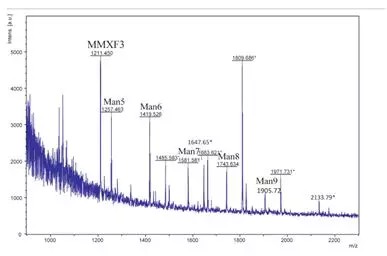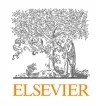JACI:纖維素上的CCD表位是ImmunoCAP過敏檢測中出現(xiàn)假陽性結(jié)果的原因之一
發(fā)布日期:2018-11-13
原標(biāo)題:ImmunoCAP所用纖維素含有碳水化合物交叉反應(yīng)決定簇(CCD)表位,在有高抗CCD IgE抗體水平的病人中能引起假陽性的檢測結(jié)果

延伸閱讀

JACI
https://doi.org/10.1016/j.jaci.2017.04.028
Abstract:
Background
Cross-reactive carbohydrate determinants (CCDs) in plants and insect venoms are a common cause of irrelevant positive test results during in vitro allergy diagnosis. We observed that some CCD-positive sera show nonspecific IgE binding even with CCD-free recombinant allergens when using the Phadia ImmunoCAP platform.
Objective
We investigated whether cellulose used as an allergen carrier in ImmunoCAP harbors residual N-glycans, causing nonspecific background binding in CCD-positive sera.
Methods
IgE binding to 6 samples of blank ImmunoCAPs coupled to either streptavidin (SA-CAP-1 or 2) or nonallergenic maltose-binding protein (MBP; MBP-CAP-1 to 4) and binding to a panel of 4 recombinant allergens were compared in CCD-positive sera before and after inhibition with a CCD inhibitor (MUXF3–human serum albumin).
Results
Of 52 CCD-positive sera (bromelain, 1.01-59.6 kilounits of antigen per liter [kUA/L]) tested on SA-CAP-1, 35 (67%) showed IgE binding of greater than 0.35 kUA/L (0.41-4.22 kUA/L).
Among those with anti-CCD IgE levels of greater than 7.0 kUA/L, 90% (26/29) were positive. IgE binding to SA-CAP-1 correlated with IgE binding to bromelain (r = 0.68) and was completely abolished by serum preincubation with the CCD inhibitor (n = 15). Binding scores with SA-CAP-2 and MBP-CAP-1 to MBP-CAP-4 were generally lower but strongly correlated with those of SA-CAP-1 and bromelain. IgE reactivity of 10 CCD-positive sera (14.0-52.5 kUA/L) with the recombinant allergens rPhl p 12, rFel d 1, rAra h 2, and rPru p 3 was positive to at least 1 allergen in 8 of 10 (0.36-1.63 kUA/L) and borderline in 2 of 10 (0.21-0.25 kUA/L). Binding correlated with antibody binding to bromelain (r = 0.61) and to all blank ImmunoCAPs (r > 0.90) and could be completely blocked by the CCD inhibitor. Overall, mean background binding to cellulose CCDs corresponded to 2% to 3% of the reactivity seen with bromelain.
Conclusions
Cellulose used as a solid-phase allergen carrier can contain varying amounts of CCDs sufficient to cause false-positive test results up to 2 kUA/L with nonglycosylated recombinant allergens in patients with high levels of anti-CCD IgE antibodies.
All Authors:
lWolfgangHemmerPhDaFriedrichAltmannPhDbFriedrichHolzweberMDcClemensGruberPhDbFelixWantkeMDaStefanW?hrlMD, MSca


——來自浙大迪迅
①植物和昆蟲毒液中交叉反應(yīng)性碳水化合物決定因子(CCDs)是體外過敏診斷中假陽性檢測結(jié)果的常見原因。我們觀察到,在使用Phadia ImmunoCAP平臺時,一些CCD陽性血清甚至與無CCD的重組變應(yīng)原發(fā)生非特異性IgE結(jié)合。②我們研究了ImmunoCAP中作為過敏原蛋白載體的纖維素中是否隱藏有N –多糖殘基,在CCD陽性血清中引起非特異性結(jié)合。③在CCD陽性血清中,在應(yīng)用CCD抑制劑(MUXF3–人血清白蛋白)進行抑制前后,對IgE與偶聯(lián)有鏈霉親和素(SA-CAP-1 或 2)或非過敏性麥芽結(jié)合蛋白(MBP; MBP-CAP-1 至 4)的6種空白ImmunoCAP樣本結(jié)合能力以及IgE與4種重組過敏原的結(jié)合能力進行比較。③在SA-CAP-1檢測的52例CCD陽性血清(菠蘿蛋白酶, 1.01-59.6 kUA/L)中,35例(67%)IgE結(jié)合大于0.35 kUA/L (0.41-4.22 kUA/L)。在抗CCD IgE水平大于7.0 kUA/L的人群中,90%(26/29)為陽性。IgE與SA-CAP-1的結(jié)合能力與IgE與菠蘿蛋白酶的結(jié)合能力有相關(guān)性(r = 0.68),通過血清與CCD抑制劑的預(yù)孵育完全消除(n = 15)。與SA-CAP-2和MBP-CAP-1至MBP-CAP-4的結(jié)合能力普遍較低,但與SA-CAP-1和菠蘿蛋白酶的結(jié)合能力密切相關(guān)。10個CCD陽性血清(14.0-52.5 kUA/L)與重組過敏原rPhl p 12, rFel d 1, rAra h 2, 和 rPru p 3IgE反應(yīng)性顯示,有8個至少對一種呈陽性(0.36-1.63 kUA/L),其余2個的值也在臨界附近(0.21-0.25 kUA/L)。結(jié)合程度與抗體和菠蘿蛋白酶的結(jié)合程度相關(guān)(r=0.61),也與和所有空白ImmunoCAPs的結(jié)合相關(guān)(r=0.90),并且能完全被CCD抑制劑阻止,總體來說,與纖維素CCD的平均結(jié)合作用相當(dāng)于與菠蘿蛋白酶反應(yīng)能力的2% - 3%。④纖維素作為一種固相過敏原載體,可含有不同數(shù)量的CCD,足以導(dǎo)致在抗CCD IgE抗體水平較高的患者中,非糖基化重組過敏原的假陽性檢測結(jié)果高達2 KUA/L。
延伸閱讀

JACI
[IF:13.1]
ImmunoCAP cellulose displays cross-reactive carbohydrate determinant (CCD) epitopes and can cause false-positive test results in patients with high anti-CCD IgE antibody levelshttps://doi.org/10.1016/j.jaci.2017.04.028
Abstract:
Background
Cross-reactive carbohydrate determinants (CCDs) in plants and insect venoms are a common cause of irrelevant positive test results during in vitro allergy diagnosis. We observed that some CCD-positive sera show nonspecific IgE binding even with CCD-free recombinant allergens when using the Phadia ImmunoCAP platform.
Objective
We investigated whether cellulose used as an allergen carrier in ImmunoCAP harbors residual N-glycans, causing nonspecific background binding in CCD-positive sera.
Methods
IgE binding to 6 samples of blank ImmunoCAPs coupled to either streptavidin (SA-CAP-1 or 2) or nonallergenic maltose-binding protein (MBP; MBP-CAP-1 to 4) and binding to a panel of 4 recombinant allergens were compared in CCD-positive sera before and after inhibition with a CCD inhibitor (MUXF3–human serum albumin).
Results
Of 52 CCD-positive sera (bromelain, 1.01-59.6 kilounits of antigen per liter [kUA/L]) tested on SA-CAP-1, 35 (67%) showed IgE binding of greater than 0.35 kUA/L (0.41-4.22 kUA/L).
Among those with anti-CCD IgE levels of greater than 7.0 kUA/L, 90% (26/29) were positive. IgE binding to SA-CAP-1 correlated with IgE binding to bromelain (r = 0.68) and was completely abolished by serum preincubation with the CCD inhibitor (n = 15). Binding scores with SA-CAP-2 and MBP-CAP-1 to MBP-CAP-4 were generally lower but strongly correlated with those of SA-CAP-1 and bromelain. IgE reactivity of 10 CCD-positive sera (14.0-52.5 kUA/L) with the recombinant allergens rPhl p 12, rFel d 1, rAra h 2, and rPru p 3 was positive to at least 1 allergen in 8 of 10 (0.36-1.63 kUA/L) and borderline in 2 of 10 (0.21-0.25 kUA/L). Binding correlated with antibody binding to bromelain (r = 0.61) and to all blank ImmunoCAPs (r > 0.90) and could be completely blocked by the CCD inhibitor. Overall, mean background binding to cellulose CCDs corresponded to 2% to 3% of the reactivity seen with bromelain.
Conclusions
Cellulose used as a solid-phase allergen carrier can contain varying amounts of CCDs sufficient to cause false-positive test results up to 2 kUA/L with nonglycosylated recombinant allergens in patients with high levels of anti-CCD IgE antibodies.
All Authors:
lWolfgangHemmerPhDaFriedrichAltmannPhDbFriedrichHolzweberMDcClemensGruberPhDbFelixWantkeMDaStefanW?hrlMD, MSca
2018-11-10 Article
創(chuàng)建過敏性疾病的科研、科普知識交流平臺,為過敏患者提供專業(yè)診斷、治療、預(yù)防的共享平臺。

 杭州浙大迪迅生物基因工程有限公司
杭州浙大迪迅生物基因工程有限公司

